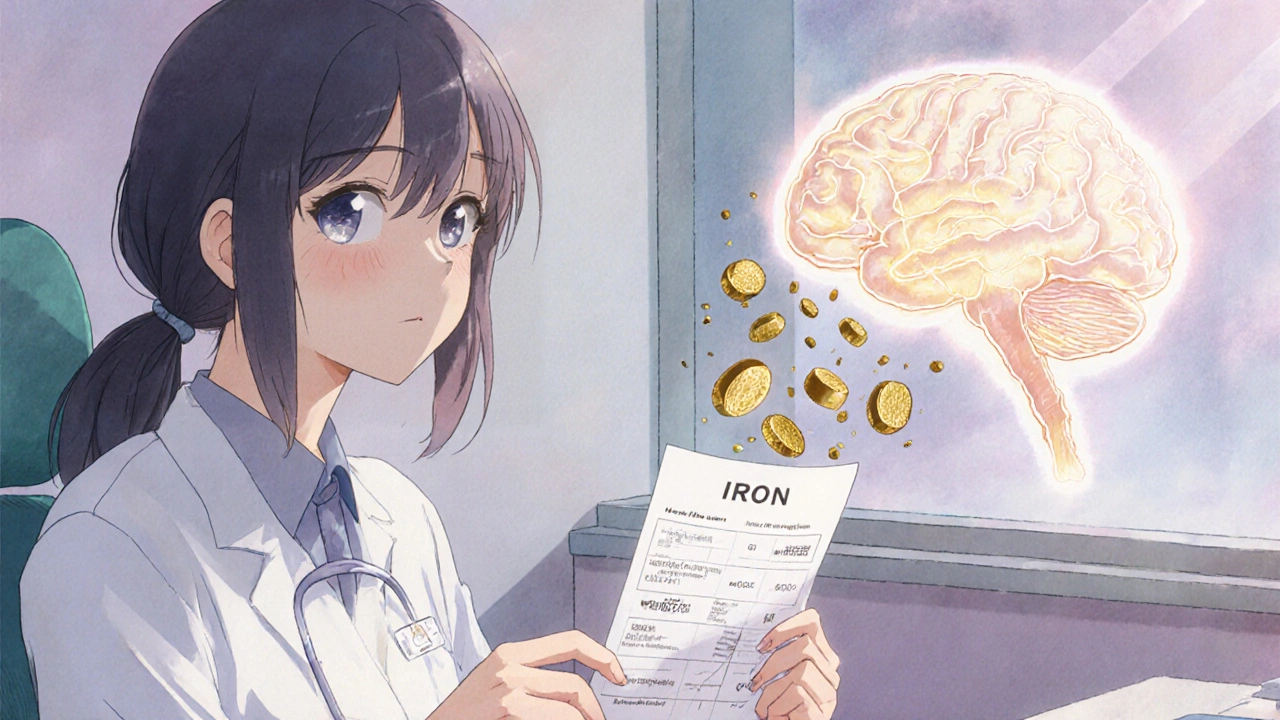What Restless Legs Syndrome Really Feels Like
You lie down to sleep, and suddenly your legs feel like they’re crawling with ants, tingling, aching, or burning. You can’t ignore it. You get up, pace around, stretch, rub your legs-anything to make it stop. Five minutes later, you’re back in bed, and it’s back. This isn’t just restlessness. It’s Restless Legs Syndrome, or RLS, also called Willis-Ekbom disease. It doesn’t show up on X-rays or blood tests. But for 1 in 10 adults in the U.S., it’s the reason they’re exhausted every morning.
RLS isn’t just about discomfort. It’s a neurological glitch that hijacks your nervous system, especially at night. The urge to move isn’t anxiety or boredom-it’s a physical compulsion tied to how your brain handles dopamine. And when sleep gets shattered night after night, the consequences ripple through every part of your life: focus fades, mood drops, driving becomes risky, and even simple tasks feel overwhelming.
Why Your Legs Won’t Stay Still at Night
RLS follows a strict schedule. Symptoms creep in during quiet moments-sitting in a movie theater, watching TV, or trying to fall asleep. They peak between 8 p.m. and midnight. And they vanish when you move. That’s the key. It’s not muscle cramps. It’s not nerve damage. It’s a brain signal gone wrong.
Research shows the problem starts in the basal ganglia, where dopamine helps control movement. People with RLS have 20-30% less dopamine transporter activity in that area. Iron deficiency in the substantia nigra makes it worse. Iron helps produce dopamine. Low iron? Less dopamine signaling. That’s why checking ferritin levels isn’t optional-it’s critical. If your ferritin is below 75 ng/mL, iron therapy can cut symptoms by 30-40%.
And it’s not just your legs. About 85% of people with RLS also have Periodic Limb Movement Disorder (PLMD). That means while you’re asleep, your legs jerk every 20-40 seconds, sometimes 100 times an hour. You don’t remember it. But your sleep does. Polysomnography studies show RLS patients spend 25-40% more time in light sleep and lose 30-50% of deep, restorative sleep. That’s why you wake up tired-even after eight hours in bed.
Dopaminergic Therapy: Fast Relief, Hidden Costs
For decades, the go-to fix for RLS has been dopamine-boosting drugs. Ropinirole, pramipexole, and rotigotine are FDA-approved and work fast-often within an hour. They target D3 receptors, calming the urge to move. In clinical trials, these drugs cut symptom scores by 40-50%. Many patients describe them as life-changing: “I slept through the night for the first time in 15 years.”
But there’s a dark side. Up to 70% of people on long-term dopamine therapy develop something called augmentation. Symptoms start earlier-maybe at noon instead of midnight. They spread to arms or torso. They get worse, not better. And the dose you took last month? Now it’s not enough. So you increase it. And the cycle tightens.
Rotigotine (the patch) has the lowest augmentation risk-around 26% after three years. Pramipexole? Up to 66%. That’s why experts now warn against using dopamine agonists for daily, chronic RLS. They’re brilliant for occasional symptoms-like a long flight or a weekend away. But for nightly struggles? The cost outweighs the benefit.

The Better Alternative: Alpha-2-Delta Ligands
There’s another option that doesn’t mess with dopamine: gabapentin enacarbil and pregabalin. These are anti-seizure drugs repurposed for RLS. They don’t give you instant relief. It takes two to four weeks. But once they kick in, they work just as well as dopamine drugs-with far fewer side effects.
A 2021 head-to-head study in JAMA Neurology found pregabalin (300 mg nightly) reduced RLS symptoms almost identically to pramipexole. But augmentation? Only 8% with pregabalin versus 32% with pramipexole after six months. That’s a massive difference. And unlike dopamine drugs, they don’t trigger impulse control disorders. No gambling sprees, no shopping binges, no reckless behavior.
Cost is a factor. Dopamine drugs run $800-$1,200 a year. Pregabalin and gabapentin enacarbil cost $1,500-$2,000. But if you factor in missed work, doctor visits for augmentation, or therapy for compulsive behaviors? The cheaper option might be the more expensive one.
Iron, Sleep Hygiene, and the Non-Drug Approach
Before you reach for a pill, check your iron. Many people with RLS are told they’re “fine” because their hemoglobin is normal. But ferritin tells a different story. Even mild iron deficiency-below 75 ng/mL-can fuel RLS. IV iron infusions (ferric carboxymaltose) can bring relief in weeks. One study showed 60% of patients had major improvement after one infusion.
And don’t underestimate sleep habits. Caffeine, alcohol, and nicotine make RLS worse. So does lying in bed awake for hours. Stick to a bedtime. Keep your room cool. Avoid screens an hour before sleep. Walk for 20 minutes in the evening-movement helps, and it’s free.
Exercise isn’t a cure, but it’s a buffer. People who walk daily report less severe symptoms. Stretching before bed helps too. Yoga and light resistance training can improve sleep quality without drugs.

What Real Patients Are Saying
On Reddit’s r/RLS, 65% of long-term users eventually switch from dopamine agonists to pregabalin or gabapentin. One user wrote: “I was on pramipexole for 18 months. Started feeling the urge at 2 p.m. My arms got involved. I was terrified I was losing control. Switching to pregabalin saved me.”
Another shared: “I spent $20,000 on online shopping because I couldn’t stop. My husband found the credit card statements. I didn’t even remember buying half of it. That’s when I knew I needed to stop the dopamine pill.”
Positive stories exist too. “Ropinirole let me sleep with my wife again after 10 years of separate beds.” But even then, they monitor closely. Weekly symptom logs. Tracking when the urge starts. Where it spreads. That’s how you catch augmentation early.
How to Manage RLS Long-Term
There’s no one-size-fits-all. But here’s what works for most people:
- Get your ferritin tested. If it’s below 75 ng/mL, talk to your doctor about IV iron.
- Start with non-drug strategies: sleep routine, avoid caffeine, evening walks.
- If symptoms are nightly and moderate to severe, try pregabalin or gabapentin enacarbil first.
- If you need dopamine drugs, use the lowest dose possible-ropinirole 0.25 mg or pramipexole 0.125 mg-and never exceed 4 mg or 0.5 mg daily.
- Keep a symptom diary. Note time of onset, body parts affected, and severity (0-10 scale).
- Re-evaluate every 3-6 months. If symptoms are worsening or starting earlier, it’s augmentation. Don’t push the dose-switch meds.
What’s Next for RLS Treatment
New drugs are coming. Fipamezole, an alpha-2 adrenergic antagonist, showed 35% less augmentation than pramipexole in early trials. Intranasal apomorphine could offer fast relief without long-term exposure. And in 2023, an extended-release version of ropinirole (Requip XL) hit the market with a 18% augmentation rate-half that of the old version.
Genetics might soon guide treatment. Variants in the BTBD9 and MEIS1 genes can predict who’s likely to respond to pramipexole-or who’s at high risk for augmentation. A 2022 study got 72% accuracy using just two gene markers.
But right now, the best tool is awareness. RLS isn’t just “nervous legs.” It’s a real, measurable neurological condition. And the right treatment isn’t always the fastest one. It’s the one that lets you sleep-without trading your life for a few good nights.
Is Restless Legs Syndrome the same as leg cramps?
No. Leg cramps are sudden, painful muscle contractions that last seconds to minutes. RLS is an uncomfortable, tingling, crawling sensation that creates an irresistible urge to move. It’s not painful like a cramp, but it’s more disruptive because it happens repeatedly, especially at night, and movement only gives temporary relief.
Can iron supplements help with RLS?
Yes-if you’re deficient. Oral iron often doesn’t work well because absorption is poor. IV iron infusions (ferric carboxymaltose) are more effective and can reduce symptoms by 30-40% in people with serum ferritin below 75 ng/mL. Always test your ferritin before starting treatment.
Why do dopamine medications stop working over time?
Long-term use can cause augmentation-a worsening of symptoms where they start earlier in the day, spread to other body parts, or become more intense. This isn’t tolerance-it’s a neurological change triggered by constant dopamine stimulation. The brain starts to rely on the drug, and symptoms rebound harder. That’s why guidelines now recommend avoiding dopamine drugs for daily RLS.
Are there any natural remedies for RLS?
Some people find relief with magnesium, folate, or reducing caffeine and alcohol. Regular moderate exercise and leg massages help too. But these are supportive-not replacements for medical treatment. If symptoms are severe, they won’t be enough. Always pair natural approaches with professional care.
Can RLS lead to other health problems?
Yes. Chronic sleep loss from RLS increases risks for depression, anxiety, high blood pressure, and type 2 diabetes. It also impairs memory and attention by 20-30%. Studies show people with RLS are 2.3 times more likely to be in a car accident due to daytime drowsiness. Treating RLS isn’t just about sleep-it’s about protecting your long-term health.


Jennifer Stephenson
November 16, 2025 AT 12:21Iron levels matter. Ferritin under 75? Try IV iron. Simple.
Vera Wayne
November 16, 2025 AT 22:20I was on pramipexole for years-felt like my brain was rewired. Then I switched to pregabalin. No more 2 p.m. leg panic. No more shopping sprees I didn’t remember. My husband says I’m human again. 🙏
Also, walking 20 minutes before bed? Game changer. Not magic, but real. And free.
Rodney Keats
November 17, 2025 AT 02:05Oh wow, so the ‘life-changing’ dopamine drug that made me spend $12k on vintage socks and cry at dog videos… was the problem? Thanks, doctor. I’ll just take the $2000 pill that doesn’t turn me into a compulsive hoarder. Of course.
Also, why is this even a thing? Who decided ‘let’s make people’s legs feel like ants are auditioning for a Broadway show’?
Laura-Jade Vaughan
November 18, 2025 AT 05:10Okay but have y’all seen the new extended-release ropinirole? Requip XL? 😍
Augmentation rate cut in half? 18%? That’s basically the Beyoncé of RLS meds-smooth, elegant, and doesn’t ruin your life. 🎶💃
Also, IV iron? Yes. My ferritin was 42. After one infusion? I slept 7 hours straight. For the first time since 2017. I cried. (In a good way.)
And no, magnesium gummies won’t fix this. Sorry, TikTok healers. 🙃
Philip Rindom
November 19, 2025 AT 15:32I get what you’re saying about dopamine drugs, but I’ve been on ropinirole 0.25 mg for 5 years and it’s still working. No augmentation. No weird impulses. Maybe it’s the dose? Or luck?
Also, I do the evening walk, avoid caffeine after 2 p.m., and sleep in a cool room. It’s not a cure, but it’s a team effort. No single thing fixed me.
Ashley B
November 19, 2025 AT 23:53They’re hiding the truth. Dopamine drugs are a pharma scam. Iron deficiency? Maybe. But what about EMFs? 5G? The government’s been injecting lithium into the water supply since 2010 to keep people docile. That’s why your legs crawl.
They don’t want you to know you can cure RLS with copper bracelets and moon water. But I’ve got the documents. Send me your email. I’ll send you the PDF.
Sharon Campbell
November 21, 2025 AT 07:24lol who even cares. i just drink wine and ignore my legs. they chill after a while. also why is everyone so serious about this? its just legs. 😴
sara styles
November 22, 2025 AT 19:32You’re all missing the point. RLS isn’t neurological-it’s a sign your mitochondria are being attacked by glyphosate-laced GMO corn. The real solution? Organic sweet potatoes, red light therapy, and avoiding fluorescent lighting after sunset. The dopamine drugs? They’re just covering up the real issue: corporate poisoning.
And don’t even get me started on ferritin tests. They’re calibrated wrong. The real cutoff is 90 ng/mL, not 75. I’ve got 12 peer-reviewed papers to prove it. Want me to send them? I’ll even highlight the relevant paragraphs.
Brendan Peterson
November 23, 2025 AT 04:35Interesting data, but I’d caution against over-relying on studies. Individual variability is huge. My cousin had RLS for 20 years, tried everything-IV iron, pregabalin, even acupuncture. Nothing worked. Then she started sleeping on a copper mat. No joke. She hasn’t had a symptom in 14 months.
Maybe it’s placebo. Maybe it’s not. But if it works… why not?
Jessica M
November 24, 2025 AT 11:18Thank you for this comprehensive, evidence-based overview. As a neurology nurse practitioner, I see RLS daily. The most common mistake? Delaying ferritin testing until symptoms are severe. Early intervention with IV iron, even in the absence of anemia, prevents progression.
Also: pregabalin enacarbil is underutilized. It’s not first-line in many clinics due to cost-but when you factor in lost productivity, ER visits for augmentation, and psychiatric side effects, it’s the most cost-effective option long-term.
And yes-sleep hygiene matters. But it’s not ‘just sleep hygiene.’ It’s neurobiology. Your circadian rhythm regulates dopamine receptors. Disrupt it, and you worsen RLS. Simple as that.
Segun Kareem
November 24, 2025 AT 22:47From Nigeria, where we don’t have access to these fancy meds-but we do have warm oil massages, deep breathing, and walking barefoot on grass at dusk. My aunt had RLS for 30 years. She never took a pill. She just moved. Always moved. And she lived to 92.
Maybe the answer isn’t in a pill bottle. Maybe it’s in rhythm. In motion. In connection to the earth.
Science is great. But don’t forget the wisdom of bodies that have been moving since before labs existed.
Jess Redfearn
November 26, 2025 AT 11:08Wait, so you’re telling me I shouldn’t take the pill that makes me sleep? But I have a presentation tomorrow. What do I do? Just rub my legs and hope? That’s not a solution. That’s just waiting to die.
Also, can I just take the iron and skip the rest? I hate walking.
Erika Lukacs
November 28, 2025 AT 04:10One wonders whether RLS is merely a metaphor for modern existence: the constant, unrelenting urge to move, to do, to consume-yet never reaching rest. The dopamine agonist becomes the opioid of productivity. The augmentation, the inevitable collapse of meaning under artificial stimulation.
Perhaps the real cure is not in iron or gabapentin, but in surrendering to stillness. And yet-how can one surrender when the body screams?